Catalina 355 Test Sail
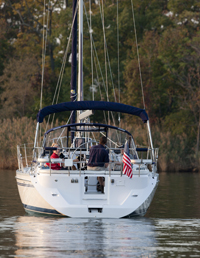 The American-built Catalinas lean toward substance over style. They may not have the flash and dash of European competitors but deliver the goods when it comes to stable cruising yachts. The new 355, which took out a 2011 Domestic Boat of the Year award, is no exception.Following on from the big brother 445, in what is a more performance-orientated range (albeit described by designer Gerry Douglas as a “more traditionally shaped cruiser”), the 355 features modest beam and topsides combined with a low-profile coachroof.A brief walkthrough showed the brand’s trademark features: sheltered cockpit, wide sidedecks. and low-maintenance and hardwearing deck surfaces. However, improvements were there to be seen such as instrument readouts nestled on either side of the helm and winches nearer to hand for the steerer as well.
The American-built Catalinas lean toward substance over style. They may not have the flash and dash of European competitors but deliver the goods when it comes to stable cruising yachts. The new 355, which took out a 2011 Domestic Boat of the Year award, is no exception.Following on from the big brother 445, in what is a more performance-orientated range (albeit described by designer Gerry Douglas as a “more traditionally shaped cruiser”), the 355 features modest beam and topsides combined with a low-profile coachroof.A brief walkthrough showed the brand’s trademark features: sheltered cockpit, wide sidedecks. and low-maintenance and hardwearing deck surfaces. However, improvements were there to be seen such as instrument readouts nestled on either side of the helm and winches nearer to hand for the steerer as well.Cockpit entry should suit all ages thanks to the stepped-transom opening, aided by the optional folding Lewmar steering wheel which increases access. The binnacle is functional, perhaps at the expense of aesthetics, with engine controls all to hand, and a stainless steel chartplotter frame (lower than previous boats to give unobstructed views forward for smaller sailors) that housed a Garmin plotter on our test boat.
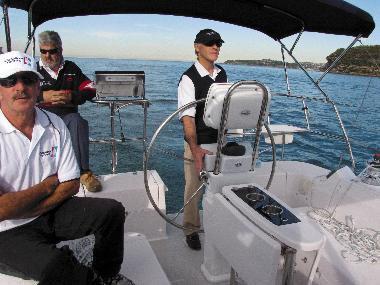 Other instrumentation is outboard, where Raymarine ST60 readouts fit nicely in the cockpit coamings and angled upward for easy viewing. Nearby, the primary Lewmar winches are big enough for one-handed use while you steer with the other. Ideal. The only problem with the binnacle setup is the danger of jamming your hands in the wheel spokes while operating the throttle. Alternatively, you can stretch your hand over the wheel top to access it.Just in front of the binnacle is the table, strongly made from stainless steel and finished in GRP (a solid teak version is optional), with icebox inbuilt and even a small LED nightlight above. The deck-level toe support also works when bracing on the wide cockpit seats, which sit nice and deep below the coamings. Here also is a cavernous port locker with gull-wing lid that can easily swallow a deflated dinghy or folding bicycle.
Other instrumentation is outboard, where Raymarine ST60 readouts fit nicely in the cockpit coamings and angled upward for easy viewing. Nearby, the primary Lewmar winches are big enough for one-handed use while you steer with the other. Ideal. The only problem with the binnacle setup is the danger of jamming your hands in the wheel spokes while operating the throttle. Alternatively, you can stretch your hand over the wheel top to access it.Just in front of the binnacle is the table, strongly made from stainless steel and finished in GRP (a solid teak version is optional), with icebox inbuilt and even a small LED nightlight above. The deck-level toe support also works when bracing on the wide cockpit seats, which sit nice and deep below the coamings. Here also is a cavernous port locker with gull-wing lid that can easily swallow a deflated dinghy or folding bicycle.
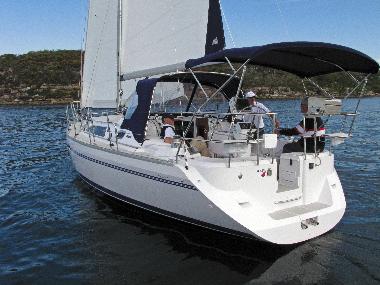 Behind the wheel, a removable transom bulkhead doubles as a safety aid (that meets US Coastguard standards requiring every vessel to have a throwable floatation device). Removing it gives access to the small swimplatform and fold-down ladder, once the lifelines are slid inside the pulpit rails; yet another neat idea.
Behind the wheel, a removable transom bulkhead doubles as a safety aid (that meets US Coastguard standards requiring every vessel to have a throwable floatation device). Removing it gives access to the small swimplatform and fold-down ladder, once the lifelines are slid inside the pulpit rails; yet another neat idea.
Weather protection, a key point in any serious cruising boat, is one of the best examples I’ve seen in a long time thanks to the tall optional dodger and wide-gauge stainless steel strutted bimini. Stainless steel rails also adorn the cockpit jammer area, where a pair of oversized Lewmars deal with all the halyards and in-mast mainsail lines. I also liked the halyard holder hooks (rather than bags that cause mildew) and a simple but effective mainsheet quick-release jammer.
Moving forward is helped by the wide decks and grippy non-slip underfoot. Reflecting the 355’s traditional approach, a good old-fashioned aluminium toerail is fitted. It may look dated but is a safe place for your feet when wrestling with a foredeck sail-change in a blow. Also good in a blow are the 28in-high lifelines located slightly inboard that allow the average sailor to reach them without stooping, while the other hand has a heavy stainless steel cabin-top grabrail. Lifeline gates are fitted on either side as well.
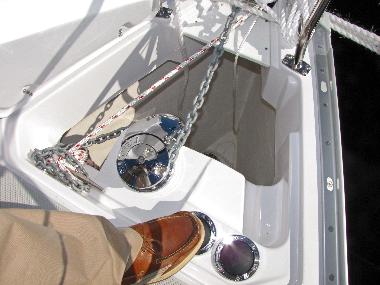 Another essential on a serious cruising boat is a good anchor setup and again the 355 comes up trumps with double rollers leading down into a deep anchor locker. A Maxwell RC10 vertical windlass is foot controlled with the 10in chain running through a hawsepipe to ensure no snags. Bow cleats are perhaps slightly undersized but warps can run easily thanks to rollers on the fairleads, a useful fixing that reduces chafe as well as helping with warp handling.
Another essential on a serious cruising boat is a good anchor setup and again the 355 comes up trumps with double rollers leading down into a deep anchor locker. A Maxwell RC10 vertical windlass is foot controlled with the 10in chain running through a hawsepipe to ensure no snags. Bow cleats are perhaps slightly undersized but warps can run easily thanks to rollers on the fairleads, a useful fixing that reduces chafe as well as helping with warp handling.
Looking at the deck-stepped Selden alloy rig, the relatively tall mast comes standard now with in-mast furling and the test boat was also fitted with the optional bowsprit — it retracts back into the anchor well and when extended it deploys an asymmetric spinnaker or cruising chute (from a mini-roller furler). Long car tracks located inboard means plenty of adjustment for different headsail options, as you’d want on a cruiser.
TRADITIONAL SALOON
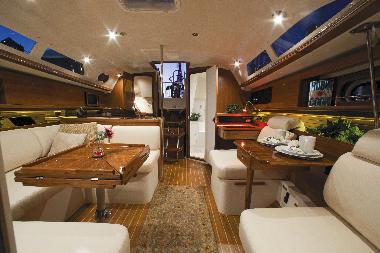 Entering the saloon is a non-traditional affair due to saloon-style doors, something I’m not a fan of — choose Catalina’s optional washboards for offshore work. The Catalina’s two-cabin layout has the owner’s double berth up front and a starboardside double at the stern.
Entering the saloon is a non-traditional affair due to saloon-style doors, something I’m not a fan of — choose Catalina’s optional washboards for offshore work. The Catalina’s two-cabin layout has the owner’s double berth up front and a starboardside double at the stern.
The forward cabin is comfortably proportioned with a unique articulating bed that is raised by an electric motor, so handy for watching a bulkhead-mounted flatscreen television. Like the rest of the boat the area has excellent storage space, including a cedar lined and ventilated hanging locker plus underfloor storage as well — a good nook to stash some wine to keep at a stable temperature. Ventilation should also be good, thanks to the forward-facing bow hatch venting air into this cabin, and through the rest of the boat.
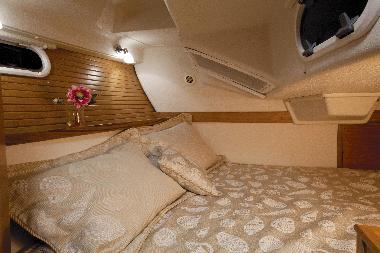 The stern cabin door protrudes into the galley, which is not ideal. Inside, a sprung mattress with 6ft6in/2m legroom stretches across the boat’s beam, so should ensure a comfortable rest. Natural light looked better than normally found in this layout thanks to three windows, including an escape hatch leading into the cockpit in case of a galley fire. Other good details include wide bookshelf space and LED spotlights to help you enjoy a night read.
The stern cabin door protrudes into the galley, which is not ideal. Inside, a sprung mattress with 6ft6in/2m legroom stretches across the boat’s beam, so should ensure a comfortable rest. Natural light looked better than normally found in this layout thanks to three windows, including an escape hatch leading into the cockpit in case of a galley fire. Other good details include wide bookshelf space and LED spotlights to help you enjoy a night read.
The saloon will appeal to traditionalists thanks to a pleasant mix of polished solid teak and matched grain cabinetry, with sliding screens coming out of the midships ones to cover the portholes. The cabin is also fitted with blinds for port and starboard windows adding privacy at the marina.
In the dinette, a solid teak quad-folding table rotates and lowers to become a bunk, as does the portside coffee-table lounge area with movable headrests, providing good ergonomics to the single seats. Adjoining this area, the chart table has an inset laptop moulding with cable ports and a vertical sliding lid to secure it, while also opening up to reveal a traditional chart table space beneath. A smoked glass door shades the electrical panel and allows viewing thanks to bright digital readouts for key statistics such as battery current. Forward of it is another panel for auxiliary systems, such as air-conditioning and watermaker while also housing the holding tank monitor.
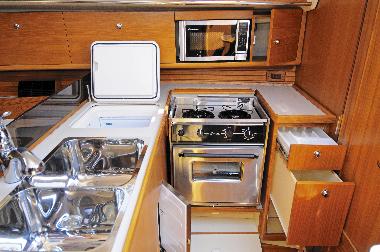 The galley has a roomy chest fridge with separate internal freezer unit and even a light. This L-shaped unit encroaches below the sink to eke out extra cold space and, cleverly, also has a bottom door. For cooking, the double burner stove and oven looks adequate, along with the factory-fitted microwave (it can be replaced with another matching-grain cabin door). Lockers are well thought out, with a mix of ample vertical height for bottles and guided support legs for all crockery. Sensibly, there are twin sinks, with plenty of depth and an extendable tap hose. Water supply won’t be a problem as there is a whopping 404lt in the tank.
The galley has a roomy chest fridge with separate internal freezer unit and even a light. This L-shaped unit encroaches below the sink to eke out extra cold space and, cleverly, also has a bottom door. For cooking, the double burner stove and oven looks adequate, along with the factory-fitted microwave (it can be replaced with another matching-grain cabin door). Lockers are well thought out, with a mix of ample vertical height for bottles and guided support legs for all crockery. Sensibly, there are twin sinks, with plenty of depth and an extendable tap hose. Water supply won’t be a problem as there is a whopping 404lt in the tank.
SPA HEAD
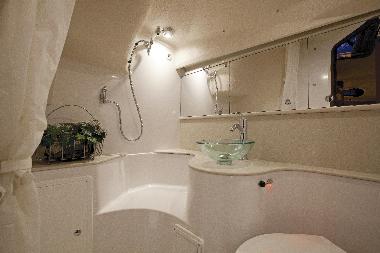 Ablutions are also practically taken care of in the port-quarter head that adjoins the companionway steps for easy off-watch crew undressing. Dubbed a “spa-style” head by designer Douglas, it has the latest fashion item increasingly used on boats: a hardened glass bowl instead of a sink. But the benefits are practical, with a lot of counter and under-locker space saved with this simple layout. The shower drains to a greywater collection box in the bilges containing the obligatory bilge pump. A single-button operates the electric macerating head, so no dramas with hand pumps and seacock taps.
Ablutions are also practically taken care of in the port-quarter head that adjoins the companionway steps for easy off-watch crew undressing. Dubbed a “spa-style” head by designer Douglas, it has the latest fashion item increasingly used on boats: a hardened glass bowl instead of a sink. But the benefits are practical, with a lot of counter and under-locker space saved with this simple layout. The shower drains to a greywater collection box in the bilges containing the obligatory bilge pump. A single-button operates the electric macerating head, so no dramas with hand pumps and seacock taps.
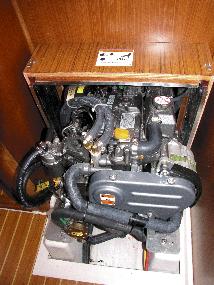 Engine noise was acceptable below decks during our motor-out thanks to the thick teak cabinetry, insulated with foam and foil. It houses the 30hp Yanmar 3YM shaftdrive engine sitting high on raised mounts. Servicing essentials, including impeller, oil and water, are prominently placed while the filters are in a separate cabinet in the head. One downside is the onerous job of accessing the engine, though. This requires unclipping the steps, unclipping the rather cumbersome box then finding somewhere to move it while you work on the engine. European builders simply fit gas struts, so the companionway cants to instantly reveal the donk. However, for oil checks, a small top hatch is fitted. Other practical touches below include substantial handrails and a roof support post — all good for crew safety in a seaway.
Engine noise was acceptable below decks during our motor-out thanks to the thick teak cabinetry, insulated with foam and foil. It houses the 30hp Yanmar 3YM shaftdrive engine sitting high on raised mounts. Servicing essentials, including impeller, oil and water, are prominently placed while the filters are in a separate cabinet in the head. One downside is the onerous job of accessing the engine, though. This requires unclipping the steps, unclipping the rather cumbersome box then finding somewhere to move it while you work on the engine. European builders simply fit gas struts, so the companionway cants to instantly reveal the donk. However, for oil checks, a small top hatch is fitted. Other practical touches below include substantial handrails and a roof support post — all good for crew safety in a seaway.
CLASSIC HULL SHAPE
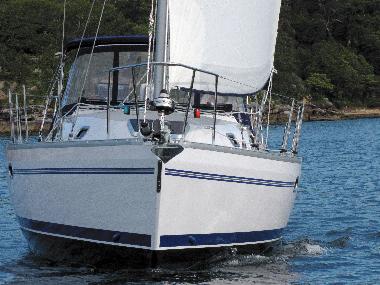 Forward raked lines and a fine bow entry combined with lightly flared topsides give the 355 an overall pleasing shape, very much in the classic tradition. Construction is the company’s well proven GRP with balsa core for both hull above the waterline (below is traditional solid fibreglass) and deck, and all fittings have backing plates.
Forward raked lines and a fine bow entry combined with lightly flared topsides give the 355 an overall pleasing shape, very much in the classic tradition. Construction is the company’s well proven GRP with balsa core for both hull above the waterline (below is traditional solid fibreglass) and deck, and all fittings have backing plates.
The bow section is well padded with a foam-filled anchor locker base and behind the actual anchor well is a high-density foam collision bulkhead (in case of those bingles on the Intercoastal Waterway, no doubt!). Also, I believe a topside rubbing strip is available, another good feature of this well thought-out boat.
Below the waterline a flattened stern section reduces drag and, a big differentiator from its European competitors is the lead keel fitted as standard, aiding both stability and stiffness going to windward. The test boat came with the shallower wing keel, one reason why Catalinas are popular in the Gippsland Lakes, which is 453kg heavier than the deeper fin. The wing model gives the 355 impressive stability, with a ballast ratio of 42 per cent and a very sober 17.76 SAD (sail to displacement ratio), so she should hold her sail plan well in a blow.
LIGHT-WIND PERFORMANCE
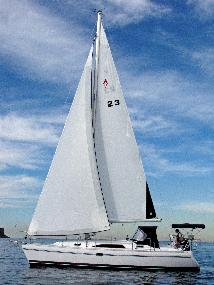 Light airs are not generally welcomed by sailboat testers but they do tell us one important thing — how efficient a boat really is. This is because every nuance is magnified, from the crispness of a tack to the efficiency of the rig, and I must confess here and now that the 355 really did surprise me.
Light airs are not generally welcomed by sailboat testers but they do tell us one important thing — how efficient a boat really is. This is because every nuance is magnified, from the crispness of a tack to the efficiency of the rig, and I must confess here and now that the 355 really did surprise me.
A variable 6kts of wind, mixed with zephyrs of slightly more pressure had me tacking the 355 sporadically to maximise every shift and squeeze every ounce of boat speed out of the 35.5-foot hull. This was easily done single-handed thanks to the primary winches right back at the stern quarters, where I could turn the wheel and with my other hand trim the genoa sheet.
On the cabin top the mainsheet was operated by distributor Norman Ambrose, who clearly was enjoying showing off the first Catalina 355 to grace our Australian waters. Earlier, we had easily pulled the outhaul to draw the Doyle mainsail out of the Selden mast. I noted a lot of shroud support at the mast intended to minimise mast distortion, something that has been known to hamper furling under heavy conditions in this style of rig. Also ball and socket chainplates are a quality addition for maintaining the deck’s integrity.
Off Middle Head in Sydney Harbour I continued coaxing the 355 to windward and thankfully there was little chop. Seated comfortably out on the gunwale with the Raymarine ST60 showing 40 per cent on the wind, we glided speedily at 4.4kts with barely 5kts of wind. Impressive.
The Edson cable steering, through a fairly large diameter wheel felt comfortable and with enough feel to keep you in touch. Throwing in a few gybes showed that the sheets ran easily and despite the wing keel’s greater friction the boat turned nimbly.
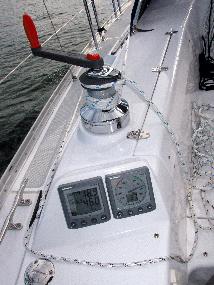 The cabin-wide mainsheet track, like most fixtures on the 355 was oversize so easily worked by one hand. As thoughts began to turn towards deploying a UPS spinnaker from the bowsprit the weather gods decided to call a halt unfortunately. I quickly furled the genoa and motorsailed back towards the Catalina anchorage at Middle Harbour with the Yanmar and its fixed three-bladed propeller pushing us along at 7kts, the revs showing 3650. Under full power the steering wheel remained neutral, didn’t vibrate and the boat generally handled well, so again no complaints.
The cabin-wide mainsheet track, like most fixtures on the 355 was oversize so easily worked by one hand. As thoughts began to turn towards deploying a UPS spinnaker from the bowsprit the weather gods decided to call a halt unfortunately. I quickly furled the genoa and motorsailed back towards the Catalina anchorage at Middle Harbour with the Yanmar and its fixed three-bladed propeller pushing us along at 7kts, the revs showing 3650. Under full power the steering wheel remained neutral, didn’t vibrate and the boat generally handled well, so again no complaints.
The Catalina company’s cruising pedigree is clearly on-show in the 355: good attention to detail and excellent build quality, combined in a lively package — all the ingredients that make this a capable bluewater cruising boat.
(Facts&figures)
CATALINA 355
AT THE HELM
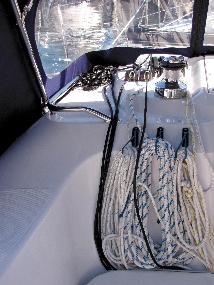 Sail handling is a simple affair on the 355, with roller-furling mainsail and headsail, while in the protected cockpit the primary winches can be easily handled by the steerer. Furthermore, this more performance orientated range lives up to its design brief with the asymmetric spinnaker flying from a retractable bowsprit.
Sail handling is a simple affair on the 355, with roller-furling mainsail and headsail, while in the protected cockpit the primary winches can be easily handled by the steerer. Furthermore, this more performance orientated range lives up to its design brief with the asymmetric spinnaker flying from a retractable bowsprit.
PRICE AS TESTED
$220,000 (price correct at time of publication)
GENERAL
MATERIAL: GRP
TYPE: Keelboat
LENGTH OVERALL: 10.76m (35ft5in)
WATERLINE LENGTH: 9.17m
BEAM: 3.65m
DRAFT: 2.2m (fin); 1.37m (wing keel)
WEIGHT: 6704kg
CAPACITIES
FUEL: 113lt
WATER: 404lt
HOLDING TANK: 102lt
CABINS: 2
LAYOUT
The Catalina 355 has a two-cabin layout with the owner’s double berth up front and a starboardside double at the stern, with bed using the full beam of the boat.
ENGINE
MAKE/MODEL: Yanmar 3YM30
RATED HP: 30
SAILS
TOTAL AREA: 62m² (genoa & mainsail)
SUPPLIED BY
Ausail Marine Group,
Pier E, The Promenade,
Sanctuary Cove, QLD, 4212,
Phone: (07) 5514 8541; 0418 257 611
Fax: (07) 5514 8543
Email: info@ausailmarine.com.au
And,
Pittwater Yacht Sales,
HolmePort Marina,
Church Point, NSW, 2105
Phone: (02) 9979 7217; 0418 232 425
Email: Maurice@catalina.com.au
Website: www.catalina.com.au
Tradeaboat says…
The American-built Catalinas have a long history in Australia. As ever, the honest yachts lean toward substance over style, and space over pure performance. They may not have the flash and dash of European competitors but deliver the goods when it comes to stable cruising yachts. The 355 continues this ethos, while also flaunting more modern lines. Easy sail handling rounds out what might be the perfect family cruising yacht.

